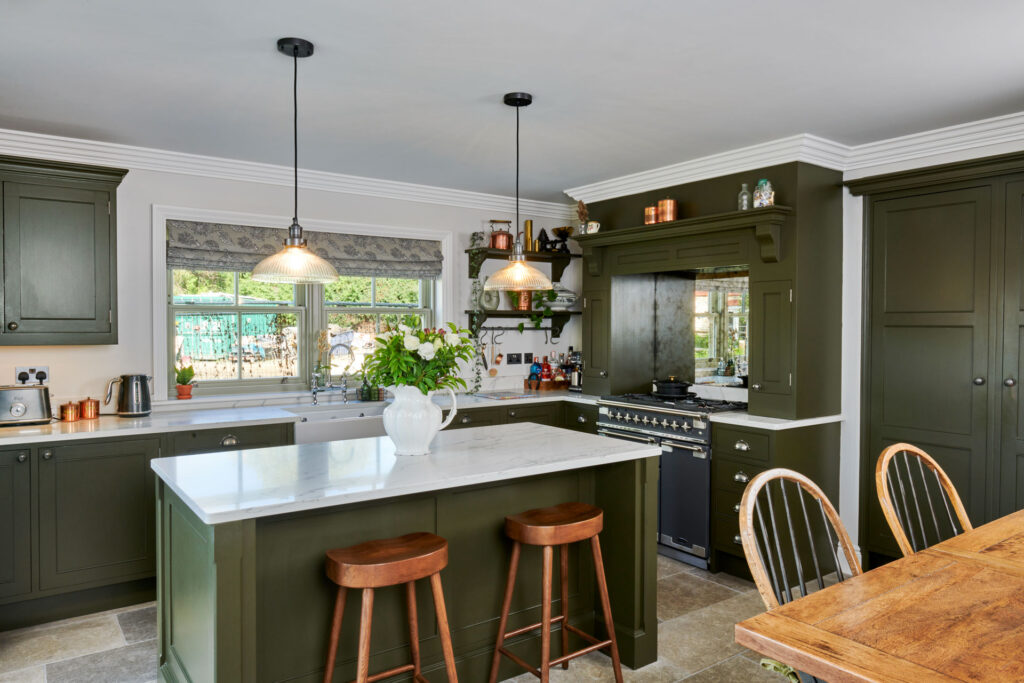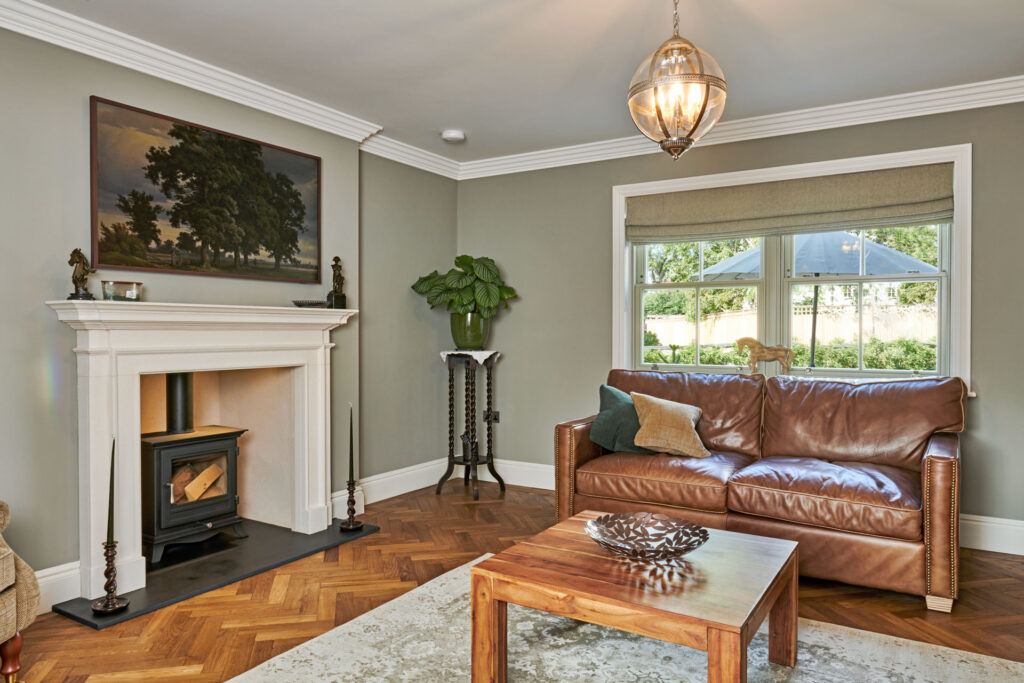At first glance, this traditional modest family home – which sits amongst a mixture of individual detached properties, a stone’s throw from the South Downs in the picturesque village of Ditchling – could have been a feature here for 100 years.
The reality is that Lime Tree House and its occupants (Scott, Emma, Austen [10] and Alvia [4]) have just celebrated their first year in this mock-period property, with construction of this self-build dream having concluded in October 2022.
Emma and Scott say there was no question who they would appoint as the builder. They chose Benjamin Allen for our proven track record of building high quality period-style homes in the local area.
When the opportunity first presented itself to Emma and Scott, nothing happened quickly. They had to sell a property and navigate the planning process with both the local district council and the South Downs National Park. But the duo had watched enough episodes of Grand Designs to know that good things will come to those who wait!
A now neighbour of the couple, an architect by trade, produced line drawings for their dwelling. They immediately felt the property could lend itself to being period in style, which suited their preference for interior decoration, too. The planning department granted planning permission but expressed a strong desire for render to be used on the property. This was in contrast to the mock-Victorian style Emma and Scott were beginning to plan for; they had already spent hours researching brick arches and alcove details for front doors.
Resigned to this preference from the planners in the South Downs National Park, Emma and Scott set about using their free time (when they were not busy working or raising their young family) to research render products. They had been watching another self-build property come to life in a nearby village that was mock-Tudor in style, and Emma took the initiative to write to them to enquire about what they had used.
The homeowner was happy to provide details of the product they had chosen, as well as contact details for the tradesman that had done the work. The decision was made to go with a lime render – it was better for the environment, more traditional in appearance, and was notoriously good at standing the test of time.


Benjamin Allen was able to assist in sourcing handmade bricks and clay tiles, with Emma and Scott electing for a mix of colours.
Emma and Scott used traditional timber sash windows; we recommended sourcing these from Bereco. The couple had seen plenty of great examples of these windows being used in other properties built by Benjamin Allen and felt as though they were sympathetic to the cosmetics of the village. Emma chose the colour RAL7032 Pebble Grey for the windows and external doors, as she believed this would stand out against the render at the front and complement the colours within the brick work. The door furniture was all available in Pewter, which is consistent with the choices inside the property for light switches, plug sockets and lights.
They had the option to choose a different colour for the inside of the windows, which they almost did in a bid to keep the inside as neutral as possible. Given the number of other things to invest in during the project, and the fact that green was the client’s interior colour of choice, they decided they would keep the colour on both sides. Both Emma and Scott report being really pleased that they did, as both the children’s bedrooms now sport wooden solid shutters painted in Pebble Grey, which are in keeping with the traditional style of their home.
They were set on having a free-standing bath in the family bathroom and immediately were drawn to the cast iron variety. Eventually, however, they invested in a tin clad copper bath, which weighed significantly less but had all the charm they were hoping for. On a clear day, you can see the rolling green South Downs from the bath!
Lime Tree House features a handmade wooden traditional style kitchen with ‘Devol-esque’ detailing on the doors, tulip wood carcus and oak insides. Emma and Scott chose grey limestone tiles for the floor which seemlessly run from the hallway into the kitchen and utility room. They complement the grey limestone small rectangular pavers used for the garden patio, accessed from the kitchen. All the floor and wall tiles were sourced from Mandarin Stone.
The downstairs cloakroom is referred to as Emma’s favourite room in the house and is akin to something from a museum, not least thanks to the walnut throne toilet seat and high-level traditional cistern with pull flush. It was once pointed out to the couple that this was one of the most frequented rooms in a house by visitors, so one worthy of attention to detail. The painter subcontracted to work on their property pointed out when painting the panelling in the lower half of the room that any adjoining wood should also be painted the same shade, which led to the door frame and then inside of the door being painted in Slaked Lime Deep (Little Greene), a slight contrast to the Slaked Lime Mid (on the wall) and the Shirtings (also Little Greene), which is on the other internal doors throughout the rest of the property.
The cast iron radiators on the first floor continue the period feel of the property, and they do a wonderful job of heating quickly when required and retaining the heat for some time afterwards. The downstairs floor has underfloor hearing throughout, with the manifold neatly situated in a cupboard in the hallway serving to make a perfect cupboard for coats to be stored in.
The staircase was very much Scott’s department, having been inspired by a love of grand National Trust properties visited over the years. This features a walnut continuous handrail, exposed cut string and monkey tail detail. Emma took over when it came to choosing the carpet, however, opting for a green stripe stair runner, olive cotton tape binding and pewter stair rod with a Thistle finial – a nod to Emma’s Scottish heritage and the location of their wedding almost 12 years ago.
Emma and Scott had the freedom to choose much of their own design elements, but they appreciated being able to lean on Benjamin Allen for recommendations.
The result is quite simply a stunning home that looks like it’s always been part of the Sussex landscape. So much so, in fact, that the property was featured in an article by the local Historical Society.
The name of the house is a nod to the mature trees that sit pride of place either side of the entrance.
Whilst they were tempted to get everything done interior-wise as quickly as possible, both Emma and Scott have enjoyed spending the first year in the property perusing antique fairs and shops to collect individual and often genuine antiques to complement the décor in this brand-new property.
The couple have various ideas about what the future of Lime Tree House will hold, with works already underway to further extend the garden.

Contact us
Information